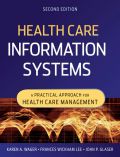
Health care information systems: a practical approach for health care management
Wager, Karen A.
Lee, Frances W.
Praise for the First Edition: ‘This should be required reading for all healthcare administrators... This book is grounded in this research, which is a strong point. Gives some practical advice on how to manage the project to success. This experience is invaluable.’ -- Anne M Bobb, BS Pharm(Northwestern Memorial Hospital), in Doody Publishing, Managing Health Information Systems is a primary text on the effective use of data and information technology to improve organizational performance in the health care settings. This book provides thefundamental knowledge and tools that students need to manage information and information resources effectively within a variety of health care organizations. Students will gain insight into the origins and uses of health information and learn about a variety of health information systems in use today, with a focus on electronic medical record systems. Written by leading experts, the book teaches key principles, methods, and applications necessary to provide access to timely, complete, accurate, legible, and relevant health care information. Included are foundations of health care information management; the history,legacy, and future of health care information systems; the architecture and technologies that support health care information systems; and the challenges for senior management in information technology, such as organization, alignment with strategic planning, governance, planning initiatives, and assessing andachieving value. Comprehensive in scope, Managing Health Care Information Systems includes substantial discussion of data quality, regulation, laws, and standards; strategies for system acquisition, use, and support; and standards and security. Each chapter includes an overview and summary of the material, as well as learning activities. The activities provide students with the opportunity to explore more fully the concepts presented. Case studies and discussion questions are presented throughout. The book concludes with strategies and methods for assessing the value of health information systems. In this timely second edition, the authors have added new sections on personal health records, e-prescribing, the federal National Health Information Network, interoperability, and heath care (standards) transparency. There will also be an increased focus on wireless technology, portable devices, and Web 2.0 platforms. Instructors' support in the way of course outlines, test banks, and PowerPoint slides will be available for faculty.
- ISBN: 978-0-470-38780-1
- Editorial: John Wiley & Sons
- Encuadernacion: Rústica
- Páginas: 544
- Fecha Publicación: 10/06/2009
- Nº Volúmenes: 1
- Idioma: Inglés
